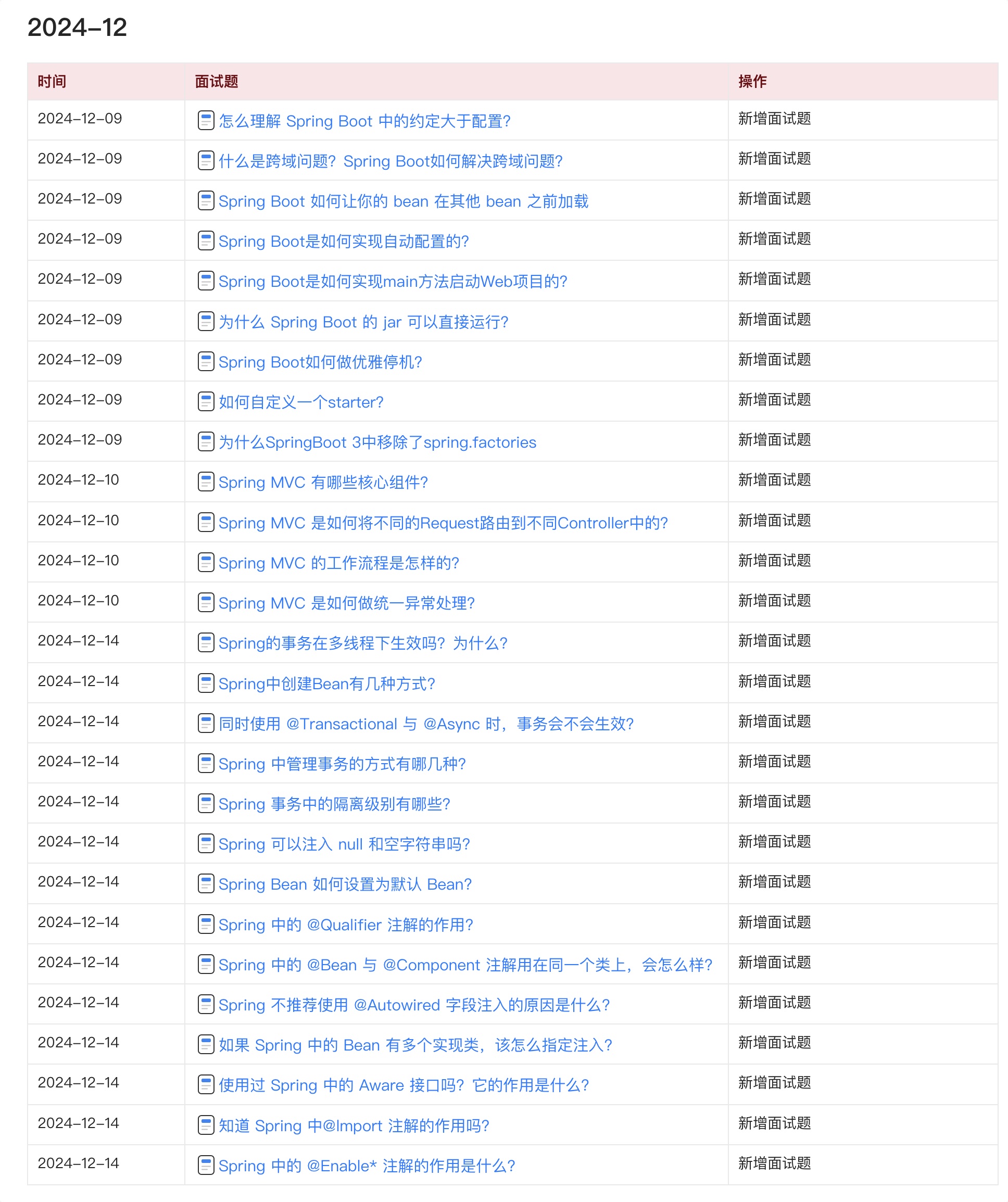在上篇博客【死磕Spring】----- IOC 之解析 Bean 标签:BeanDefinition中已经完成了对 Bean 标签属性的解析工作,这篇博文开始分析子元素的解析。完成 Bean 标签基本属性解析后,会依次调用 parseMetaElements()、parseLookupOverrideSubElements()、parseReplacedMethodSubElements() 对子元素 meta、lookup-method、replace-method 完成解析。三个子元素的作用如下:
- meta:元数据。
- lookup-method:Spring 动态改变 bean 里方法的实现。方法执行返回的对象,使用 Spring 内原有的这类对象替换,通过改变方法返回值来动态改变方法。内部实现为使用 cglib 方法,重新生成子类,重写配置的方法和返回对象,达到动态改变的效果。
- replace-method:Spring 动态改变 bean 里方法的实现。需要改变的方法,使用 Spring 内原有其他类(需要继承接口
org.springframework.beans.factory.support.MethodReplacer)的逻辑,替换这个方法。通过改变方法执行逻辑来动态改变方法。
meta 子元素
meta :元数据。当需要使用里面的信息时可以通过key获取
meta 所声明的 key 并不会在 Bean 中体现,只是一个额外的声明,当我们需要使用里面的信息时,通过 BeanDefinition 的 getAttribute() 获取。该子元素的解析过程如下:
public void parseMetaElements(Element ele, BeanMetadataAttributeAccessor attributeAccessor) {
NodeList nl = ele.getChildNodes();
for (int i = 0; i < nl.getLength(); i++) {
Node node = nl.item(i);
if (isCandidateElement(node) && nodeNameEquals(node, META_ELEMENT)) {
Element metaElement = (Element) node;
String key = metaElement.getAttribute(KEY_ATTRIBUTE);
String value = metaElement.getAttribute(VALUE_ATTRIBUTE);
BeanMetadataAttribute attribute = new BeanMetadataAttribute(key, value);
attribute.setSource(extractSource(metaElement));
attributeAccessor.addMetadataAttribute(attribute);
}
}
}
解析过程较为简单,获取相应的 key - value 构建 BeanMetadataAttribute 对象,然后通过 addMetadataAttribute() 加入到 AbstractBeanDefinition 中。 `` 如下:
public void addMetadataAttribute(BeanMetadataAttribute attribute) {
super.setAttribute(attribute.getName(), attribute);
}
委托 AttributeAccessorSupport 实现,如下:
public void setAttribute(String name, @Nullable Object value) {
Assert.notNull(name, "Name must not be null");
if (value != null) {
this.attributes.put(name, value);
}
else {
removeAttribute(name);
}
}
AttributeAccessorSupport 是接口 AttributeAccessor 的实现者。 AttributeAccessor 接口定义了与其他对象的元数据进行连接和访问的约定,可以通过该接口对属性进行获取、设置、删除操作。 设置元数据后,则可以通过 getAttribute() 获取,如下:
public Object getAttribute(String name) {
BeanMetadataAttribute attribute = (BeanMetadataAttribute) super.getAttribute(name);
return (attribute != null ? attribute.getValue() : null);
}
lookup-method 子元素
lookup-method :获取器注入,是把一个方法声明为返回某种类型的 bean 但实际要返回的 bean 是在配置文件里面配置的。该方法可以用于设计一些可插拔的功能上,解除程序依赖。
直接上例子:
public interface Car {
void display();
}
public class Bmw implements Car{
@Override
public void display() {
System.out.println("我是 BMW");
}
}
public class Hongqi implements Car{
@Override
public void display() {
System.out.println("我是 hongqi");
}
}
public abstract class Display {
public void display(){
getCar().display();
}
public abstract Car getCar();
}
public static void main(String[] args) {
ApplicationContext context = new ClassPathXmlApplicationContext("classpath:spring.xml");
Display display = (Display) context.getBean("display");
display.display();
}
}
配置内容如下:
<bean id="display" class="org.springframework.core.test1.Display">
<lookup-method name="getCar" bean="hongqi"/>
</bean>
运行结果为:
我是 hongqi
如果将 bean="hognqi" 替换为 bean="bmw",则运行结果变成:
我是 BMW
看了这个示例,我们初步了解了 looku-method 子元素提供的功能了,其解析过程如下:
public void parseLookupOverrideSubElements(Element beanEle, MethodOverrides overrides) {
NodeList nl = beanEle.getChildNodes();
for (int i = 0; i < nl.getLength(); i++) {
Node node = nl.item(i);
if (isCandidateElement(node) && nodeNameEquals(node, LOOKUP_METHOD_ELEMENT)) {
Element ele = (Element) node;
String methodName = ele.getAttribute(NAME_ATTRIBUTE);
String beanRef = ele.getAttribute(BEAN_ELEMENT);
LookupOverride override = new LookupOverride(methodName, beanRef);
override.setSource(extractSource(ele));
overrides.addOverride(override);
}
}
}
解析过程和 meta 子元素没有多大区别,同样是解析 methodName、beanRef 构造一个 LookupOverride 对象,然后覆盖即可。在实例化 Bean 的时候,再详细阐述具体的实现过程,这里仅仅只是一个标记作用。
replace-method 子元素
replaced-method :可以在运行时调用新的方法替换现有的方法,还能动态的更新原有方法的逻辑
该标签使用方法和 lookup-method 标签差不多,只不过替代方法的类需要实现 MethodReplacer 接口。如下:
public class Method {
public void display(){
System.out.println("我是原始方法");
}
}
public class MethodReplace implements MethodReplacer {
@Override
public Object reimplement(Object obj, Method method, Object[] args) throws Throwable {
System.out.println("我是替换方法");
return null;
}
}
public static void main(String[] args) {
ApplicationContext context = new ClassPathXmlApplicationContext("classpath:spring.xml");
Method method = (Method) context.getBean("method");
method.display();
}
如果 spring.xml 文件如下:
<bean id="methodReplace" class="org.springframework.core.test1.MethodReplace"/>
<bean id="method" class="org.springframework.core.test1.Method"/>
则运行结果为:
我是原始方法
增加 replaced-method 子元素:
<bean id="methodReplace" class="org.springframework.core.test1.MethodReplace"/>
<bean id="method" class="org.springframework.core.test1.Method">
<replaced-method name="display" replacer="methodReplace"/>
</bean>
运行结果为:
我是替换方法
上面代码演示了 replaced-method 子元素的用法,下面再看看该子元素的解析过程。
public void parseReplacedMethodSubElements(Element beanEle, MethodOverrides overrides) {
NodeList nl = beanEle.getChildNodes();
for (int i = 0; i < nl.getLength(); i++) {
Node node = nl.item(i);
if (isCandidateElement(node) && nodeNameEquals(node, REPLACED_METHOD_ELEMENT)) {
Element replacedMethodEle = (Element) node;
String name = replacedMethodEle.getAttribute(NAME_ATTRIBUTE);
String callback = replacedMethodEle.getAttribute(REPLACER_ATTRIBUTE);
ReplaceOverride replaceOverride = new ReplaceOverride(name, callback);
// Look for arg-type match elements.
List<Element> argTypeEles = DomUtils.getChildElementsByTagName(replacedMethodEle, ARG_TYPE_ELEMENT);
for (Element argTypeEle : argTypeEles) {
String match = argTypeEle.getAttribute(ARG_TYPE_MATCH_ATTRIBUTE);
match = (StringUtils.hasText(match) ? match : DomUtils.getTextValue(argTypeEle));
if (StringUtils.hasText(match)) {
replaceOverride.addTypeIdentifier(match);
}
}
replaceOverride.setSource(extractSource(replacedMethodEle));
overrides.addOverride(replaceOverride);
}
}
}
该子元素和 lookup-method 资源的解析过程差不多,同样是提取 name 和 replacer 属性构建 ReplaceOverride 对象,然后记录到 AbstractBeanDefinition 中的 methodOverrides 属性中。 对于 lookup-method 和 replaced-method 两个子元素是如何使用以完成他们所提供的功能,在后续实例化 Bean 的时候会做详细说明。
- 【死磕 Spring】—– IOC 之解析Bean:解析 import 标签
- 【死磕 Spring】----- IOC 之解析 bean 标签:开启解析进程
- 【死磕 Spring】----- IOC 之解析 bean 标签:BeanDefinition
Java 面试宝典是大明哥全力打造的 Java 精品面试题,它是一份靠谱、强大、详细、经典的 Java 后端面试宝典。它不仅仅只是一道道面试题,而是一套完整的 Java 知识体系,一套你 Java 知识点的扫盲贴。
它的内容包括:
- 大厂真题:Java 面试宝典里面的题目都是最近几年的高频的大厂面试真题。
- 原创内容:Java 面试宝典内容全部都是大明哥原创,内容全面且通俗易懂,回答部分可以直接作为面试回答内容。
- 持续更新:一次购买,永久有效。大明哥会持续更新 3+ 年,累计更新 1000+,宝典会不断迭代更新,保证最新、最全面。
- 覆盖全面:本宝典累计更新 1000+,从 Java 入门到 Java 架构的高频面试题,实现 360° 全覆盖。
- 不止面试:内容包含面试题解析、内容详解、知识扩展,它不仅仅只是一份面试题,更是一套完整的 Java 知识体系。
- 宝典详情:https://www.yuque.com/chenssy/sike-java/xvlo920axlp7sf4k
- 宝典总览:https://www.yuque.com/chenssy/sike-java/yogsehzntzgp4ly1
- 宝典进展:https://www.yuque.com/chenssy/sike-java/en9ned7loo47z5aw
目前 Java 面试宝典累计更新 400+ 道,总字数 42w+。大明哥还在持续更新中,下图是大明哥在 2024-12 月份的更新情况:

想了解详情的小伙伴,扫描下面二维码加大明哥微信【daming091】咨询

同时,大明哥也整理一套目前市面最常见的热点面试题。微信搜[大明哥聊 Java]或扫描下方二维码关注大明哥的原创公众号[大明哥聊 Java] ,回复【面试题】 即可免费领取。

